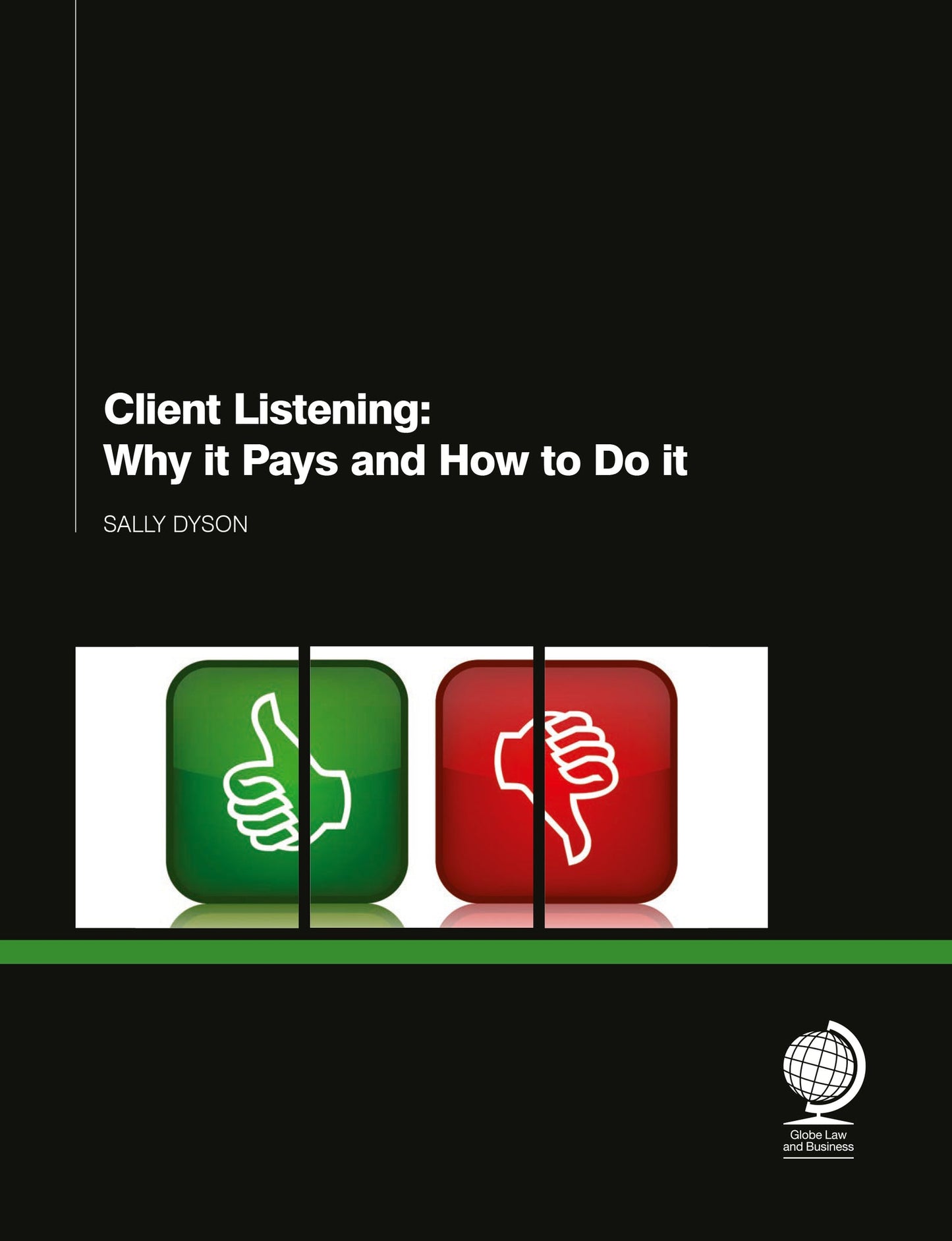We're sorry. An error has occurred
Please cancel or retry.
Client Listening
Regular price
£199.00
Sale price
£199.00
Regular price
£199.00
Unit price
/
per
Sale
Sold out
Re-stocking soon
Future-proof your firm by embedding client relationships, and anticipating client needs. Forward-thinking firms know that listening effectively to their clients is crucial for improving client serv...
Read More

Some error occured while loading the Quick View. Please close the Quick View and try reloading the page.
Couldn't load pickup availability
- Format:
-
31 March 2013

"Client listening is the single most important marketing activity." - Paul Amit, Head of Sector and Client Marketing, DLA Piper. Forward-thinking firms know that listening effectively to their clients is crucial for improving client service, value, retention, and, ultimately, profitability. It can also help future-proof your firm by embedding client relationships, and anticipating client needs. Client Listening: Why It Pays and How to Do it, will show you how to design and implement effective client listening programmes and act on the intelligence gleaned to secure these critical benefits for your firm. It highlights the important factors that must be considered before launching a client listening programme, and offers practical advice to ensure its success. Topics include how to: * Identify the role of client listening within your firm's broader CRM and BD initiatives; * Overcome typical objections from individual lawyers to engaging in client listening; * Determine the type of client listening activities which best fit your firm's culture, budget, timetable, and purposes; * Design and conduct effective client questionnaires and interviews (how-to guide included); and * Ensure client feedback is reported, shared, absorbed, and converted into action appropriately. Real-life case studies from DLA Piper, Ashurst, CMS Cameron McKenna, K&L Gates, and KPMG reveal how firms are currently using client listening as a means to deepen client relationships and develop more responsive, value-added services. Useful appendices are also included to assist you with the design, launch, and fine-tuning of your own client listening programmes. These include: * A client listening planner; * A sample client invitation; and * A sample discussion guide for a client service review.

Price: £199.00
Pages: 100
Publisher: Globe Law and Business
Imprint: Ark Group
Publication Date:
31 March 2013
Trim Size: 9.25 X 6.12 in
ISBN: 9781908640987
Format: Paperback
BISACs:
LAW, Legal Profession, Law, Legal skills & practice, LAW / General Practice, Legal profession: general

Executive summary...VII About the author...IX Acknowledgements ...XI Part One: Client listening explained Chapter 1: The trend in favour of client listening... 3 What is client listening?...3 Is client listening new?...3 Weaknesses in client listening practised by law firms...6 Other industries pointing the way forward...7 A vision for client listening in law firms...8 Chapter 2: The benefits of client listening... 11 Sustainable competitive advantage.11 Popular rationale ...11 Partner perspectives...11 Supplementary benefits...13 Measuring the return on investment14 Chapter 3: Positioning client listening in context... 19 Business development ...19 Client relationship management...21 Interplay between CRM and key account management...23 Chapter 4: Obstacles to engaging with clients... 27 Obstacle 1: There is nothing to learn...27 Rebuttal 1: Champions will demonstrate otherwise ...27 Obstacle 2: Clients will refuse to participate in formal client listening activity...28 Rebuttal 2: Clients enthusiastically embrace client listening...29 Obstacle 3: There is no time for client listening...29 Rebuttal 3: Making time...30 Obstacle 4: Lawyers are not trained interviewers...31 Rebuttal 4: Training, mentoring, and expert independent interviewers are available...31 Obstacle 5: Asking questions brings risk...32 Rebuttal 5: Don't be an ostrich!...32 Obstacle 6: Asking for feedback is pointless as no action will be taken...33 Rebuttal 6: Take responsibility ...33 Chapter 5: Selecting the best listening method... 35 Interplay between client listening and market research...35 Qualitative versus quantitative research...36 Data collection methods...37 Choosing interviewers...40 Chapter 6: An explanation of key techniques and how to handle tricky situations... 45 Preparation...45 Depth interviews...47 Questionnaires...50 Multi-jurisdictional programmes...54 Chapter 7: Ensuring that feedback is useful, user-friendly, and used... 57 Analysing free-form responses...57 Analysing numerical data ...59 Visual representations of feedback results...60 Reporting ...61 Framing recommendations...65 Chapter 8: Time to act... 67 Responding to feedback at the client level ...67 Setting firm strategy in the light of feedback comments received..68 Conclusions...71 Part Two: Case studies Case study 1: DLA Piper - International partner perspectives. 75 Case study 2: Ashurst - Responsive client service... 83 Case study 3: CMS Cameron McKenna - Applied intelligence ... 87 Case study 4: K&L GATES LLP - Beyond client listening... 93 Case Study 5: KPMG - Feedback that adds up: Lessons from accountancy... 97 Part Three: Appendices Appendix 1: Planner... 103 Appendix 2: Comparing methodologies... 105 Appendix 3: Invitation... 107 Appendix 4: Discussion guide... 109



